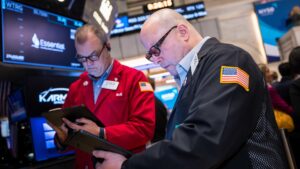The Tech Rally: Assessing the Nasdaq 100’s Sustainability and Strategic Hedging
Investor enthusiasm is palpable as the three major U.S. indexes surge to unprecedented heights. It appears that both retail and institutional investors have locked arms, riding the wave of resilience that has pushed stocks to all-time highs. With the Cboe Volatility Index (VIX) dipping to a tame 14, the environment seems almost idyllic for stock markets. However, as we at Extreme Investor Network always emphasize, it’s crucial to look beneath the surface—especially when hotter-than-expected inflation and rising interest rates suddenly seem to be fueling bullish sentiment.
A Closer Look at the Magnificent 7
The so-called “Magnificent 7” stocks—Apple, Microsoft, Amazon, Alphabet, Meta, Nvidia, and Tesla—have led this charge, but 2025 is showing signs of internal bifurcation and exhaustion. While these tech titans have propped up the Nasdaq 100 ETF (QQQ), our analysis indicates that a potential pullback looms on the horizon.
On that note, let’s take a moment to dissect current trends: the robust performance of the QQQs over the past two years has been nothing short of historic. However, we’re beginning to see signs of fatigue. Investors eagerly await Nvidia’s earnings report on February 26, which could serve as a bellwether not only for the tech sector but also for market sentiment on growth stocks.
Rotation is Key
As the earnings season unfolds, we’re noticing a rotation trade emerging towards industrials, financials, and other less glamorous blue-chip stocks. Companies like Waste Management (WM), JPMorgan Chase (JPM), and Intel (INTC) might not attract attention the way tech giants do, but they can be reliable performers—especially during market shifts.
The delayed implementation of Trump’s tariffs has momentarily relieved some pressure on the stock market, allowing traders to push fear into the rearview mirror. Nevertheless, it’s important to remain vigilant.
A Cautious Approach for 2025
Here at Extreme Investor Network, we remain cautiously optimistic for 2025. The Nasdaq 100’s streak of 485 consecutive trading days closing above its 200-day moving average is impressive but raises questions about sustainability. As the second-longest streak in history, trailing only the 572-day streak that ended in October 2018, it’s hard not to wonder: how much longer can this momentum last?
To hedge against potential downward movement in the tech-heavy index, we recommend using a risk reversal strategy in the QQQ. Let’s break it down:
-
Sell a Call Option: To offset the cost of hedging, consider selling an upside out-of-the-money call option. For example, you might sell the 3/21/2025 $555 call option for $4.00.
- Buy a Put Option: Meanwhile, buy a downside out-of-the-money put option to protect your downside exposure. An example would be purchasing the 3/21/2025 $515 put for $4.60.
This risk reversal results in a total cost of only $0.60 or $60 per one spread, which is manageable if you are holding QQQ.
Conclusion: A Path Forward
In these uncertain times, a diversified portfolio is more important than ever. By strategically hedging your tech exposure through methods like the risk reversal, you can effectively navigate the fluctuations of the Nasdaq 100 while remaining poised for opportunity in other sectors.
Remember, investing isn’t just about riding highs; it’s essential to prepare for the lows. At Extreme Investor Network, we provide you with the insights, strategies, and community support to help you stay ahead of the curve. Whether you’re an experienced investor or just starting, our resources are designed to help you make informed, data-driven choices.
Disclaimer: All opinions expressed here are for informational purposes and do not constitute financial, investment, tax, or legal advice. Always consult a qualified financial advisor before making investment decisions.

